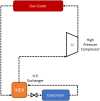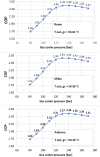The potential role of trans-critical CO2 heat pumps within a solar cooling system for building services: The hybridised system energy analysis by a dynamic simulation model
- PMID:32982085
- PMCID: PMC7505099
- DOI: 10.1016/j.renene.2020.09.098
The potential role of trans-critical CO2 heat pumps within a solar cooling system for building services: The hybridised system energy analysis by a dynamic simulation model
Abstract
The rotary desiccant wheels application in the air conditioning systems are used for the air dehumidification by means of hygroscopic layers for water vapor adsorption. Nevertheless, external heat sources are required for water desorption to close the air treatment cycle. This paper investigates on the possibility to integrate in that cycle a new component, such as thetrans-critical CO2 heat pump, to reduce the contribution of external thermal sources. In so doing, the high temperature waste heat discharged by the heat pump hot sink can be fruitfully exploited. Additionally, a PV array has been added to the typical layout based on the solar collectors, in order to assure the heat pump electrical driving. The energy analysis is carried out by calculating the energy performance indicators of the whole cooling system, simulating it by a dynamic model built in the MATLAB SIMULINK environment. Specifically, an air handling unit has been properly sized to supply cooling load to a reference conference hall of 1200 m3, with changes in boundary conditions (i.e. solar radiation, daily temperature and relative humidity variations). Indeed, three different cities representing the most typical Italian climatic zones, have been considered for assessing the proposed technical option suitability.
Keywords: CO2; Desiccant cooling; HVAC energy Efficiency; Hybrid systems; Solar cooling; Trans-critical heat pump.
© 2020 Elsevier Ltd. All rights reserved.
Conflict of interest statement
The authors declare that they have no known competing financial interests or personal relationships that could have appeared to influence the work reported in this paper.
Figures




















References
- Statistics | eurostat.https://ec.europa.eu/eurostat/databrowser/view/ten00124/default/table?la... (n.d.) accessed May 5, 2020.
- Mancini F., Nastasi B. Energy retrofitting effects on the energy flexibility of dwellings. Energies. 2019;12:2788. doi: 10.3390/en12142788. - DOI
- Lo Basso G., Nastasi B., Salata F., Golasi I. Energy retrofitting of residential buildings—how to couple Combined Heat and Power (CHP) and Heat Pump (HP) for thermal management and off-design operation. Energy Build. 2017;151:293–305. doi: 10.1016/j.enbuild.2017.06.060. - DOI
- Lo Basso G., Rosa F., Astiaso Garcia D., Cumo F. Hybrid systems adoption for lowering historic buildings PFEC (primary fossil energy consumption) - a comparative energy analysis. Renew. Energy. 2018;117:414–433. doi: 10.1016/j.renene.2017.10.099. - DOI
- De Santoli L., Lo Basso G., Spiridigliozzi G., Garcia D.A. Proc. - 2018 IEEE Int. Conf. Environ. Electr. Eng. 2018 IEEE Ind. Commer. Power Syst. Eur. EEEIC/I CPS Eur. 2018. 2018. Innovative hybrid energy systems for heading towards NZEB qualification for existing buildings. - DOI
LinkOut - more resources
Full Text Sources
Other Literature Sources